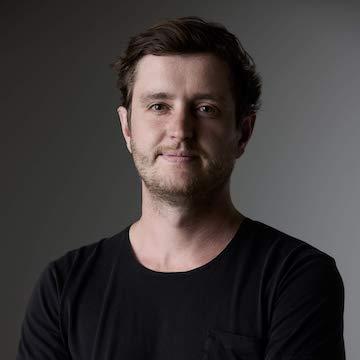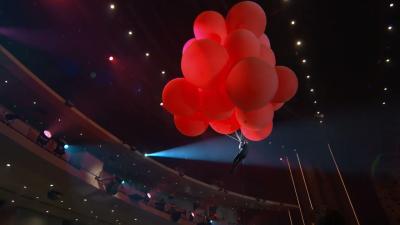Stu Dingley is a production, lighting, and show designer who joined Silent House as a designer and director in 2022. He has worked on Las Vegas residencies and the Doritos Super Bowl commercial, as well as with Shakira, The Kid Laroi, Totally Enormous Extinct Dinosaurs, and more. More recently, he worked on the current David Blaine Residency. Live Design chats with him about his career path, working with David Blaine, the advent of AI, and advice for the next generation.

Live Design: What was your career path in a nutshell?
Stu Dingley: I grew up in Lymington, Hampshire in the UK and started my career in my mid-teens working part-time at a local lighting rental company. I pursued a lighting design degree in London, then toured extensively around the world as an LD and programmer all through my twenties. In 2018, I took a leap and relocated from London to Los Angeles, immersing myself in the world of Los Angeles, while establishing a small design studio for my projects. In late 2022, Baz Halpin, founder and CEO of Silent House Group, extended an invitation for me to join the team.
LD: How do you juggle/combine various design disciplines and directing?
SD: Working as an LD gives you the opportunity to collaborate with many creative directors. You learn to adapt easily and understand various styles of communication, which makes you gain an appreciation for the bigger picture. Jumping between different roles can be challenging, but I think the key is working with people you really respect and leveraging their ideas. Also, specifically with directing, having an understanding of the headspace and vision of the artist is probably the most essential thing. It involves delving into the mindset, artistic intentions, insecurities, and creative inspirations of the performers or artists you're working with. This understanding allows you to effectively bring their vision to life and build stronger creative partnerships.
LD: What brought you to join Silent House?
SD: Joining Silent House was a decision driven by several factors that aligned perfectly with my career aspirations and ambitions. The opportunity to collaborate with a team of exceptionally talented individuals and work in an environment known for its commitment to excellence was a significant draw for me. The studio's reputation for innovative design, technical expertise, and delivering world class shows, made it an ideal fit for me as a designer seeking to challenge myself and further expand my career. I have primarily always worked on my own, so Silent House presented a supportive work environment that fosters creativity, encourages collaboration, and values the input of every team member. The prospect of working alongside like-minded individuals who share a passion for creating exceptional productions was immensely appealing to me.
LD: What are the specific challenges to working on David Blaine’s Las Vegas Residency?
SD: There are inherent risks involved in an illusionist's show that adds a layer of complexity to the lighting design decisions. Specific stunts —like the unharnessed, 80-foot ascent into the theater grid followed by a freefall into cardboard boxes—require meticulous consideration of lighting angles to ensure both safety and the desired visual impact. In the case of this opening stunt, the lighting must carefully navigate between providing adequate illumination for the audience, cameras and performer's safety, whilst avoiding angles that could potentially distract or hinder the jump. In addition to managing the high-level risks associated with these stunts, lighting design for illusionist shows also plays a pivotal role in enhancing and directing the audience's attention during more traditional tricks. The strategic use of multiple lighting positions becomes crucial in masking and revealing specific elements of the performance, as well as guiding the audience's focus to desired points of interest. Another intriguing challenge was maintaining consistent lighting conditions for the various animals in the show. The lighting must replicate the exact conditions under which they have been trained to ensure the success and repeatability of their performances.

LD: How do you think Artificial Intelligence will impact the entertainment industry?
SD: It is interesting to consider the implications of AI developments and their impact on the entertainment industry. I wonder whether lighting programming could eventually involve analyzing musicality and studying previous human-driven design choices to enable an AI model to understand the relationship between music and lighting. By exploring the connections between these elements, AI could potentially generate lighting that synchronizes with the rhythm, dynamics, and emotional nuances of the music. Essentially, AI algorithms could be trained to identify patterns and extract relevant information from audio data, allowing them to perceive the musical elements that impact lighting decisions. Another potential application is the integration of AI models and output with live show environments. For example, by taking in multiple data sets from a live show, such as audio, lighting, atmospheric, audience reactions, and performer movements, AI could analyze and interpret this information to generate dynamic and immersive video content. Essentially, Notch 2.0!
LD: What advice would you give young people entering the industry today?
SD: Gain practical experience. Value your connections. Be persistent. Maintain professionalism and try to remember, success in the entertainment industry is not solely defined by fame or fortune. It is as much about finding fulfillment in the work you do, continuously growing as an artist, and creating meaningful experiences for audiences. Stay committed, work hard, and remember to have as many laughs as you can.